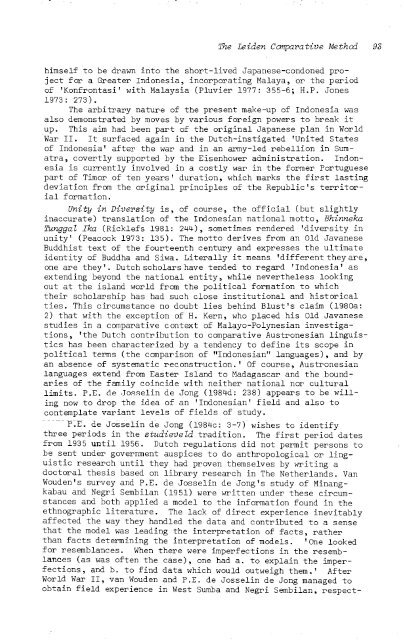Download searchable PDF of Volume 16 1985 - Institute of Social ...
Download searchable PDF of Volume 16 1985 - Institute of Social ...
Download searchable PDF of Volume 16 1985 - Institute of Social ...
You also want an ePaper? Increase the reach of your titles
YUMPU automatically turns print PDFs into web optimized ePapers that Google loves.
The Ieiden Camparative Method 93<br />
himself to be drawn into the short-lived Japanese-condoned project<br />
far a Greater Indonesia, incorporating Malaya, or the<br />
<strong>of</strong> 'Konfrontasi' with Malaysia (Pluvier 1977: 355-6; H.P. Jones<br />
1973: 273).<br />
The<br />
nature <strong>of</strong> the present make-up <strong>of</strong> Indonesia was<br />
also demonstrated by moves by various powers to break it<br />
up. This aim had been part <strong>of</strong> the Japanese plan in World<br />
War 11. It surfaced again in the Dutch-instigated 'United States<br />
<strong>of</strong> Indonesia' after the war and in an army-led rebellion in Sumatra,<br />
covertly supported by the Eisenhower administration. Indonesia<br />
is<br />
involved in a costly war in the former<br />
part <strong>of</strong> Timor <strong>of</strong> ten years' duration, which marks the first<br />
deviation from the original principles <strong>of</strong> the Republic's territorial<br />
formation.<br />
Unity in Diversity is, <strong>of</strong> course, the <strong>of</strong>ficial (but slightly<br />
inaccurate) translation <strong>of</strong> the Indonesian national motto, Bhinneka<br />
TunggaZ Ika 1981: 244), sometimes rendered in<br />
unity' (Peacock 1973: 135). The motto derives from an Old Javanese<br />
Buddhist text <strong>of</strong> the fourteenth century and expresses the ultimate<br />
identity <strong>of</strong> Buddha and Siwa. it means 'different are,<br />
one are '. Dutch scholars have tended to regard 'Indonesia' as<br />
extending the national entity, while nevertheless looking<br />
out at the island world from the<br />
formation to which<br />
their<br />
has had such close institutional and historical<br />
ties. This circumstance no doubt lies behind Blust's claim (1980a:<br />
2) that with the exception <strong>of</strong> H. Kern, who placed his Old Javanese<br />
studies in a comparative context <strong>of</strong> Malayo-Polynesian<br />
tions, 'the Dutch contribution to comparative Austronesian linguistics<br />
has been characterized by a tendency to define its scope in<br />
political terms (the comparison <strong>of</strong> "Indonesian" ), and by<br />
an absence <strong>of</strong> systematic reconstruction.' Of course, Austronesian<br />
languages extend from Easter Island to Madagascar and the boundaries<br />
<strong>of</strong> the family coincide neither national nor cultural<br />
limits. P.E. de Josselin de (1984d: 238) appears to "be willing<br />
now to drop the idea <strong>of</strong> an 'Indonesian' field and also to<br />
variant levels <strong>of</strong> fields <strong>of</strong> study.<br />
P.E. de Josselin de (1984c: 3-7) to identify<br />
three in the studieve tradition. The first period dates<br />
from 1935 until 1956. Dutch regulations did not persons to<br />
be sent under government to do anthropological or linguistic<br />
research until they had proven themselves writing a<br />
doctoral thesis based on research in The Netherlands. Van<br />
Wouden's survey and P.E. de Josselin de Jong's <strong>of</strong> Minangkabau<br />
and Negri Sembilan (19 were written under these circumstances<br />
and both applied a model to the information found in the<br />
ethnographic literature. The lack <strong>of</strong> direct<br />
inevitably<br />
affected the way they handled the data and contributed to a sense<br />
that the model was leading the interpretation <strong>of</strong> facts, rather<br />
than facts determining the interpretation <strong>of</strong> models. 'One looked<br />
for resemblances. When there were imperfections in the resemblances<br />
(as was <strong>of</strong>ten the , one had a. to the imperfections,<br />
and b. to find data which would them.' After<br />
World War 11, van Wouden and P.E. de Josselin de Jong managed to<br />
obtain field experience in West Sumba and Sembilan, respect-
















